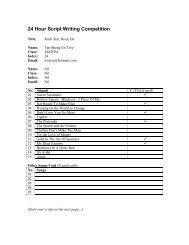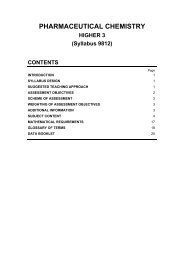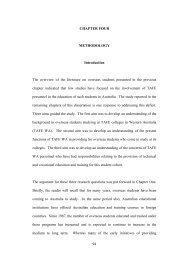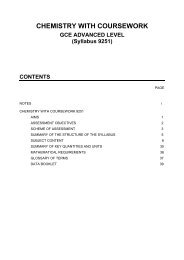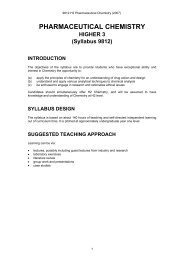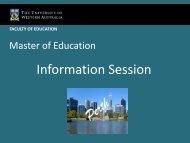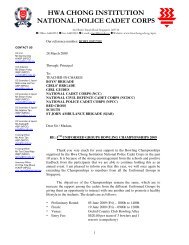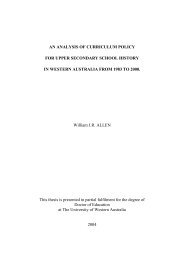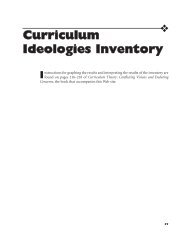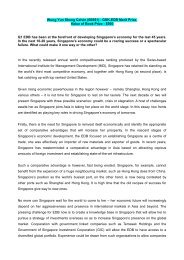EDUC 8678 - Pre-reading - Curriculum and its discontents
EDUC 8678 - Pre-reading - Curriculum and its discontents
EDUC 8678 - Pre-reading - Curriculum and its discontents
You also want an ePaper? Increase the reach of your titles
YUMPU automatically turns print PDFs into web optimized ePapers that Google loves.
166<br />
PHILIP W. JACKSON/CI<br />
why I chose that location. Hershey just feels right. Perhaps it has<br />
something to do with my childhood love of chocolate, I'm not sure.<br />
From each of these three centers, I see, in my mind's eye, lines, many of<br />
them transatlantic, connecting individuals from far-flung spots to one or<br />
another of the nuclei, thus forming three webs of overlapping <strong>and</strong><br />
crisscrossing str<strong>and</strong>s. Finally, I also envision a scattering of single,<br />
unconnected dots representing individuals who seem to be unaffiliated<br />
with any of the three centers of activity, but whose voices are clearly part of<br />
the general chorus of discontent. These solitary dots are too numerous <strong>and</strong><br />
widespread to arrange mentally, so I will simply ask that you pepper to<br />
taste your own imaginary map.<br />
My justification for thinking of the Discontents as being concentrated<br />
in this way rests on the fact that each of the three centers has spawned one or<br />
more edited volumes containing collections of essays that share a more or<br />
less common outlook on educational matters. As the best single example of<br />
the work emanating from each location, I would nominate Know ledge <strong>and</strong><br />
Control (1971), edited by Michael F. D. Young of the University of London,<br />
Beyond the Numbers Game (1977), edited by David Hamilton of the<br />
University of East Anglia <strong>and</strong> four other British educationists, <strong>and</strong><br />
<strong>Curriculum</strong> Theorizing (1975), edited by William Pinar of the University<br />
of Rochester (a bit north <strong>and</strong> west of Hershey). These three volumes,<br />
though representative, do not begin to exhaust the list that could be<br />
compiled for each cluster. They should suffice, however, to give some<br />
bibliographic justification for the divisions.<br />
By mentioning specific books I do not mean to imply, of course, that an<br />
intellectual affiliation with any of the three clusters is necessarily defined<br />
by authorship in one or more of <strong>its</strong> publications. Some contributors to the<br />
volumes associated with one of the clusters would doubtlessly complain<br />
about being identified with the dominant perspective of the book in<br />
question. Others whose writings do not appear there might well seek to be<br />
so identified. For these reasons, it makes little sense to attempt a roster of<br />
who is in or out of any of the three foci of activity.<br />
For similar reasons, I think it unwise to name the individuals whose<br />
work is salient within the total corpus of writings that deal with curricular<br />
matters but who would not appear on any one of the three rosters were I to<br />
attempt them-the solitary dots on our mental map. Suffice it to say that<br />
the group would include individuals as physically separate as Joseph<br />
Schwab in California <strong>and</strong> Ulf Lundgren in Sweden, <strong>and</strong> as ideologically<br />
distant as Elliot Eisner <strong>and</strong> Henry Levin, both of Stanford University.<br />
As I tune in, figuratively speaking, to the chorus of complaints issuing<br />
from both the clusters <strong>and</strong> the individuals, what sounds at first like a<br />
cacophonous babble later becomes slightly melodious. The same note is<br />
struck by more than one person, motifs issuing from one location are<br />
picked up in another <strong>and</strong> contrapuntal harmonies emerge. The sense of<br />
listening to a babble never disappears completely, but, later, portions of<br />
the sound become familiar enough to hum to oneself. These humable<br />
passages, at least the ones that I have managed to select, comprise a sort of<br />
litany, containing the following set of verses (to be authentic, you should<br />
chant them, I suppose, in a minor key):





